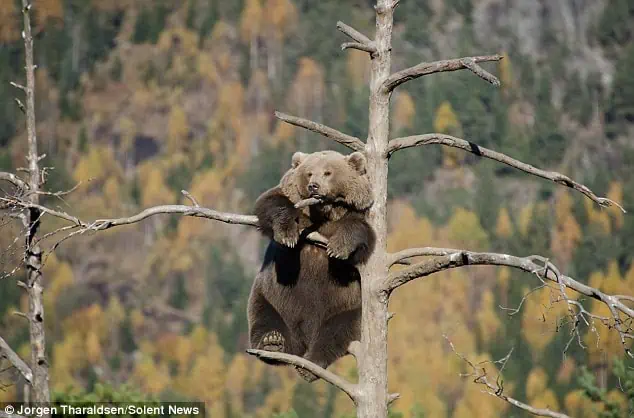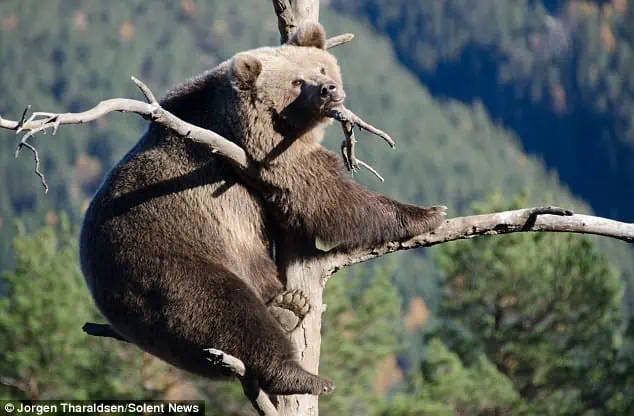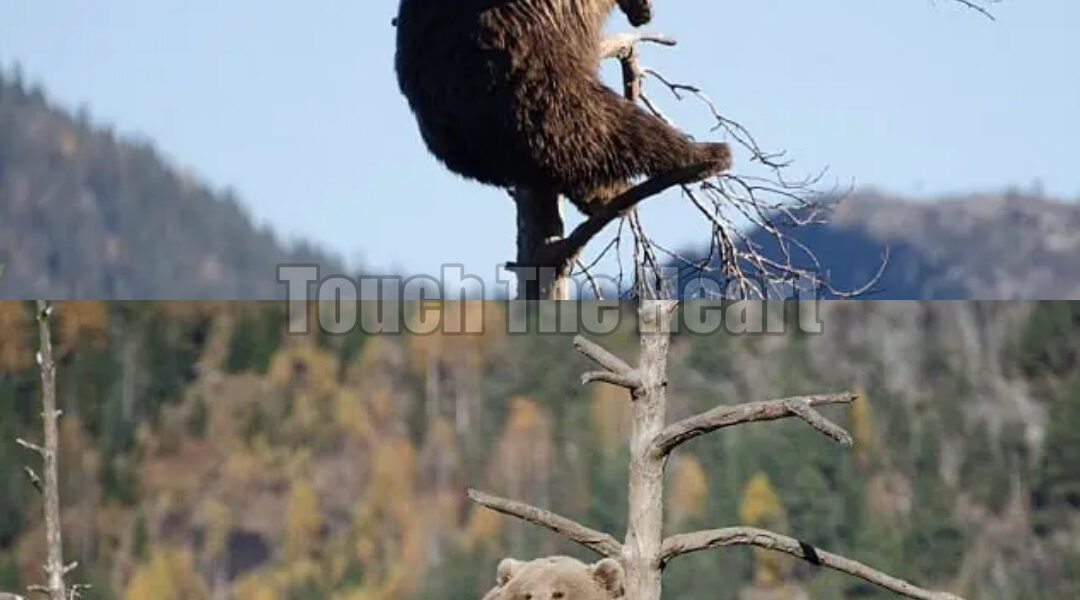It began as just another quiet afternoon in the Hallingdal valley — the kind of day when the air hangs still, when the forest feels half asleep, and when even the wind seems too tired to move the trees. Nothing in the world suggested that something extraordinary was about to happen.

But deep in the woods, where autumn leaves burned gold and rust against the sky, a young brown bear was making a decision that no one watching could have predicted.
She was only four years old — still young enough to be playful, still small compared to the giants of her species, but already learning the rules of the wild: where to find food, how to tell danger from safety, and when to run instead of fight.
Brown bears grow fast, but childhood still lingers in the way they move — curious, restless, always searching for something.
That afternoon, she wasn’t searching for food.

She was searching for peace.
Somewhere below her, the forest floor carried the heavy footsteps of a much larger male bear — older, stronger, and in the quiet politics of the wild, someone she knew not to challenge. So instead of pacing the earth, she lifted her eyes upward.
Toward the trees.
The trunk she chose was tall — impossibly tall, it seemed, reaching fifty feet into the sky like a ladder built by the wind. The branches thinned the higher they climbed, fragile-looking, narrow as fingers. They were not made to hold a bear.
But the young bear did not hesitate.

She placed her paws against the bark.
She dug in her claws.
And she climbed.
Slowly at first, then faster — the way a child climbs a tree because it feels like instinct, because it feels like freedom. Higher and higher she went until the ground was no longer a place she belonged. Until she reached the kind of branch that would make any human gasp — thin, bending, bowing under her weight…
…and she settled onto it as if it were the most natural throne in the world.
Her paws balanced on two separate branches.
Her chin rested against a third.
Her eyes looked out into the valley — the kind of view only birds are supposed to see.

And she fell asleep.
Not curled in a den.
Not hidden in a cave.
But suspended high above the earth, wrapped in sunlight and stillness, a sleeping reminder that some animals know how to trust the world in ways humans never will.
Hours passed.
And she stayed — shifting now and then, blinking awake, then drifting back into dreams while the world spun quietly below her. She was alone, yet never lonely. Vulnerable, yet completely unafraid. Her sleep was the sleep of a creature that understood the wild not as threat, but as belonging.
Far below, a man named Jorgen Tharaldsen stood frozen in awe.

He had come to the valley to photograph wildlife — to catch moments, not miracles. But what he saw through his lens was something he would remember for the rest of his life: a bear in a tree, balanced on a branch so thin it looked like a whisper against the sky.
“She shouldn’t be able to do that,” he muttered under his breath.
But she could.
Because the wild does not obey the rules we write for it.
He raised his camera, but even before he pressed the shutter, he knew what he was witnessing was not just rare — it was something deeper. Something quiet. Something sacred.

“She looked like she was dreaming,” he said later. “Like she climbed for peace, not safety.”
Maybe that was true.
Maybe animals escape in their own ways too.
Maybe even a bear needs somewhere the world cannot reach.
The autumn colors around her glowed like stained glass — yellow leaves trembling against the wind, red branches bending like ribbons, the whole world painted in slow fire. And there she was — a brown bear asleep in a cathedral of trees.
There was no fear in her eyes.
No growl.
No panic.
Just stillness — the kind humans spend lifetimes searching for and seldom find.
It would have been enough just to witness it.

But the story did not end there.
Because while she slept, the forest reminded everyone watching of the truth beneath the beauty — the ground still held danger. The massive male bear wandered below, sniffing the earth, unaware or uninterested in the young climber above him.
And suddenly, everything about her decision made sense.
She did not climb for adventure.
She climbed for safety.
She climbed because even wildness needs rest.
She climbed because life, even in the animal kingdom, is sometimes too heavy to carry on the ground.
And that was the moment Jorgen realized something that stayed with him long after he left the valley:
People talk about courage as loud, bold movement — charges, roars, defiance.

But courage also looks like quiet decisions made with no audience.
Like a small bear climbing fifty feet into the air just to find a place to breathe.
She stayed up there until the sun lowered and the shadows stretched long across the earth. Only then — slowly, gracefully — she climbed back down, branch by branch, using the same steadiness and patience that brought her up.
No drama.
No stumble.
No fear.
Just a quiet return to the world she had temporarily escaped.
The forest didn’t applaud.
The trees didn’t bend in praise.
But someone was there to remember.
And sometimes, that is enough.
Because photographs fade.

But moments like that — moments where nature reminds us how small we are, how gentle the wild can be, how much beauty still exists without needing permission — those moments stay alive long after the shutter closes.
Long after the bear disappears into the woods again.
Long after the story becomes something told instead of something seen.
Maybe that’s why the image felt almost sad, Jorgen later admitted. Not because the bear looked lonely — but because the world has forgotten what peace looks like, even when it’s sitting right in front of us on a fragile branch in the afternoon light.
And maybe that’s why stories like hers matter:
Because somewhere between climbing and resting…
between danger below and safety above…
between the wild we fear and the wild we romanticize…
…is the simple truth that all living things — even the strongest — sometimes need a quiet place to feel safe.
Even a bear.
Even us.




